 Old Fashioned Sweet Pickles
Old Fashioned Sweet PicklesCucumbers My Grandmother sliced them lengthwise into quarters, but you can slice them into 'coins' if you prefer smaller pickles.
Water
Pickling Salt - Yes, there really is a product called pickling salt. Don't use table salt as it contains iodine. Iodine has a tendency to darken pickles. Kosher salt is a suitable alternative as it contains no iodine. But if you can, use pickling salt. It can be hard to find, but worth the effort.
Alum - Used to strengthen cucumber pectin. It's what gives pickles their 'crunch'.
Pickling Spices - My grandmother had several spice combinations scratched across her recipes. I imagine it was quite common to experiment with the recipe; after all, the pickling spices are what give the pickles their flavor. Today, pickling spices can be bought commercially. Find them in the spice section.
Apple Cider VinegarSugarDay 1
Wash the cucumber rinds thoroughly. Slice into coins or lengthwise into quarters. Place slices in a large container. I used a large glass jar with glass lid. Fill the container with boiling water until all cucumbers are submerged. Leave uncover until the water comes to room temperature. When cool, cover and let rest overnight at room temperature.
Day 2
Drain a discard liquid. Boil enough water to cover the cucumbers. Add 1 1/2 C pickling salt to 1 gal. water. Pour salted, boiling water over cucumbers covering them completely. When cooled, cover. Let rest at room temperature overnight.
Day 3
Drain, discard liquid. Boil enough water to cover the cucumbers. Add 2 1/2 T. Alum to 1 gal. water. Pour over cucumbers covering them completely. When cooled, cover. Let rest at room temperature overnight.
Day 4
Drain and discard liquid. Boil apple cider vinegar, enough to cover. Add 3 T. pickling spices to 1 gal. apple cider vinegar. I'm sure my grandmother just sprinkled the spices in the vinegar before she poured it over the cucumbers as I remember spice flakes on her pickles. I chose to tie the flakes into a cheese cloth bag that I tucked into the cucumbers. You can also steep a a cheesecloth bundle into the boiling cider, discarding the bag before pouring the cider over the cucumbers. All three methods will work.
Day 5-7
Let cucumber/cider mixture rest at room temperature for three days - covered or uncovered. I suggest using a cover. The cider scent gets pretty strong by the third day.
Day 8
Drain and discard liquid and spices. Fill large bowl with sugar. One by one, dredge each cucumber in sugar, covering thoroughly. Pack tightly into jars. Sprinkle additional sugar in the jar. The result will be about one more cup of sugar in addition to the sugar coating the cucumbers. The goal is to have all air space in the jar filled with sugar. Seal jars and let the magic begin. As the sugar dissolves, it pulls moisture from the cucumbers that combines with the sugar to make a sweet syrup. It takes a few hours, but after all the sugar has 'melted' there should be enough syrup to cover the cucumbers. If not, add more sugar. Cure in a cool, dry place for several days or weeks.

My grandmother was a young woman during the depression. The 'making do' ways she learned never left her. She still used a big kettle washing machine when I was a girl, letting me crank the soggy clothes through its rubber rollers, expressing water, until they fell, stiff and flatten into the wooden basket.
Together, her with one handle, me the other, we carried the basket to the clothes line. It ran north and south - the width of her yard, just like her garden. All summer we'd weed radishes and carrots, dig potatoes, and as the corn grew, hung clothes on her line.
At summer's end, I sat in her steamy kitchen, molding holly hocks into dolls as she canned Mason jars of tomatoes and corn, peaches and relish. She's been gone for years, but every now and then, in the way we all walk a moment in the past, I remember and long to touch a crisp breeze-dried pillowcase or crunch a carrot fresh from the garden.
More than anything, I find I long for my grandmother's sweet pickles. So last summer I set out to replicate her recipe and was met with wonderful success! I'll share the recipe in my next post, but until then, check out the youtube video for making hollyhock dolls!
 A recipe for Apricot Nut Bread was published in the October 18, 1930 Homemaking Department section of the Wallaces' Farmer newspaper. Curious, not once was the type or quantity of nut mentioned in the entire recipe. As the newspaper was regional to the midwest, perhaps it was a given walnuts were the obvious choice - or chestnuts.
A recipe for Apricot Nut Bread was published in the October 18, 1930 Homemaking Department section of the Wallaces' Farmer newspaper. Curious, not once was the type or quantity of nut mentioned in the entire recipe. As the newspaper was regional to the midwest, perhaps it was a given walnuts were the obvious choice - or chestnuts.
Personally, I prefer pecans. Whatever your choice, I've copied the recipe as printed eighty years ago. Enjoy!
Photogragher : Bill Longshaw
Apricot Nut Bread
Apricot nut bread makes delicious sandwiches spread with
butter or spread the last minute with a tart jam or jelly.
1 1/2 cups of dried apricots
1/2 cup of sugar
2 tablespoons of fat
1 egg
1 cup of sour milk
1 cup of bran
2 cups of white flour
5 teaspoons of baking powder
1/2 teaspoon of soda
1/2 teaspoon of salt
Wash the apricots, boil five minutes, drain and chop. Cream the sugar with the shortening, add the well beaten egg and the milk. Combine the bran, the apricots and the nuts with the first mixture and beat thoroly (sic). Add the flour sefted with the baking powder, soda and salt, and mix well. Pour into a well greased bread pan and bake one hour in a slow oven (275 degrees Fahrenheit).
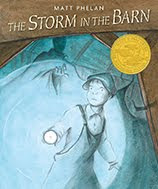
Eleven year old Jack is as broken by the Depression as the land is. At first glance, it seems the monster drought has weakened him. He's bullied by kids. His father - from whom he longs for connection and approval - is distant and disdainful and his sister, who he clearly loves and wants to save, suffers from dust pneumonia - her cure outside his control.
As this graphic novel unfolds, we witness escalating distress. He's scared by dead snakes nailed to fence posts - an old world charm to scare off agrarian disaster. The drought demon rages; looming large and hateful in the neighbor's barn. The aggression of poor Jack's world comes to a head with a sad killing scene when men set out ot tame the ravages of the land, but instead, ravage the tame.
The significant message in this book is how tragic circumstances, such as the drought, affect not only day to day living, but also family dynamics. The muted drawings capture the bleak emotion of the story. This book is a multiple award winner including the Scott O'Dell Award for historical fiction. Grades 5 and up.
A link to the publisher, Candlewick Press:
http://www.candlewick.com/cat.asp?browse-Title&isbn=0763636185&mode=book
Check out the author, Matt Phelan's website: http://www.mattphelan.com/
Phelan, Matt, The Storm in the Barn. Graphic novel illustrated by the author. Somerville, MA : Candlewick Press, 2009. (970-0-763-63618-0)
By:
Dust Bowl History,
on 8/7/2008
Blog:
Dust Bowl History
(
Login to Add to MyJacketFlap)
JacketFlap tags:
New York City,
Germany,
New Mexico,
Hitler,
sugar,
cucumbers,
Mama Fela's Girls,
brine,
Ana Baca,
1936 Olympic Games,
Olympics Games,
Sweet pickles,
Tenement Museum,
Add a tag
.JPG)
Hello, friends!
Summer is coming to an end. I know I've been quiet these past few months but that doesn't mean I've had a quiet summer. Quite the opposite!
Just as the school year ended, I found a wonderful book, Mama Fela's Girls : A Novel by Ana Baca. Set in New Mexico during the depression, it's a richly textured novel that delves into the lives of a family as it navigates stereotypes, hard times and the simple act of living and making do during the depression. I love that it represents an area of our country not often focused on. I learned so much about customs and familiar interactions in an area far from where I live. No matter where you live, in this wide and reaching country of ours, I'm sure you will, too! Watch for my review of this beautiful book!
In late June, this Iowa mom and her family had the good fortune to spend a week in New York City. It wasn't our first journey to the Big Apple, but it was my first chance to visit the Tenement Museum on the lower east side. Amazing, amazing, amazing...here's a link...stayed tuned for a report! http://www.tenement.org/
Right now, on my kitchen counter, I have a jar of cucumbers resting in a pickling spice/vinegar brine. I'm trying a depression - era recipe for making sweet pickles from scratch. Tomorrow, I separate the larger recipe into smaller jars, add sugar, then seal them for two weeks, or so. I miss my grandmother's sweet pickles so much that when I found the most wonderful cucumbers at a Farmer's Market, I decided to try to make a batch.
I can't wait to taste them. Ardith, my grandmother, was known for her pickles. I've spent a good amount of time researching recipes for pickle making...and from the scents of my kitchen, I think I'm pretty close. I'll share my sweet pickle recipe with you soon!
My final exploration for the summer has been, believe it or not, the Olympic Games. Hitler tried his best to interfer with the games when they were held in Germany in 1936. I'll share some insight and books that might help bridge the gap between the Olympics of today and how they were during the 1930's.
Hope you all had a wonderful summer!
Becky
 St. Nicholas Magazine advertisement illustration, October 1933.
St. Nicholas Magazine advertisement illustration, October 1933.
In the October, 1933 issue of St. Nicholas magazine, there is an advertisement for Baby Ruth candy bars. In the ad, the candy bar is positioned next to a glass of milk and a sandwich. The tag line reads, "Here's a Lunch...Good Candy Anytime." The important thing to note in this ad is that along with the image of a sandwich, glass of milk and candy bar, there is an endorsement emblem from the American Medical Association's Committee on Food. Apparently, back in 1933, a satisfying candy bar, rich in nougat and nuts, met a nutritional standard folks,including the AMA, could sign on to.
This ad got me thinking about our current dietary culture. We live in an age of 'super-sizing' meals. Obesity is at an all-time high. In an effort to offer more nutritionally balanced meals, fast food vendors now offer fruit, parfaits and raisons as substitutes for the more fatty fries and onion rings.
Very similar to the meal suggested in the candy bar ad, pre-packaged, lunch-time meals can be purchased in the grocery store. They offer very similar menus. Crackers paired with ham and cheese. Pizza with toppings paired with a cookie or candy bar.
I don't know about you, but I love them. I search the different options, trying to find the right combination of cookie, juice, turkey (my favorite) and cheese. And then I wonder, what made that 1933 AMA endorsed lunch suggestion that included a candy bar,so different from a lunch I choose for myself or my children - or for any of us?
Perhaps they aren't different. Perhaps, back in 1933, a candy bar was simply a way to make a lunch more inviting to the eater. Much like the offerings of cookies, candy bars and juice boxes are for pre-packaged lunches, today.
The difference between the lunch options of the 1930's and today, is that, back then, there were no pre-packaged lunches. The advertisement offered a suggested menu that would be created at home. The sandwiches, fruits and drinks would come from the kitchen of the mothers who packed them, not a factory.
We might learn something from that example. Instead of letting manufacturers choose our food for us, we could follow the teachings of St. Nicholas writers and put together lunches on our own. Lunches that are every bit as nutritious as those offered today, but with a more focused eye on nutrition combined with treats that we love to eat!
From the August, 1933 issue, sandwich suggestions include thinly sliced ham with mustard, turkey with cranberry jelly and simple peanut butter sandwiches.
Add an apple or peach or whatever fruit is in season, a mini bag of trail mix or nuts and your favorite juicebox (be sure it's pure juice)or milk. And then, for good measure, toss in a Baby Ruth ( or a candy bar of your choice). It's sweet, nutty and delicious. The perfect dessert to a wholesome lunch anyone can create in their own kitchen, just like moms and kids did during the depression.
Enjoy!Becky
 During the thirties, boys and girls loved to read St. Nicholas.
During the thirties, boys and girls loved to read St. Nicholas.
It was a magazine much like today's
Highlights magazine. It was filled with an assortment of stories by popular writers, true life essays, regular features like "The Mixing Bowl" which offered recipes, and glorious illustrations by
reknown artists. Young readers were encouraged to contribute and many poems, stories, letters and recipes were printed. It even held contests where readers could win prize money for their contributions.
In the next few entries, we'll explore St. Nicholas. It was published years before computers, television and the internet; a time that seems static by today's standards. And yet, in it's own way, it fullfilled a similar purpose for readers. It offered an avenue for dialog (letters), publication (stories, poems, etc.) and media (photograph contributions).
Today, St. Nicholas contributors, like Mary Owens Sallee (age 10), whose work I've chosen to open this discussion with, might have sent her poem to Highlights in hopes to see her poem in print. Or she might have configured her narrative into a visual message and posted it on You Tube. Or maybe, she might have blogged!
But these were not options for her back in the early months of 1933. She sent her poem to St. Nicholas Magazine. And it was not only accepted, but it earned a Silver Badge in the magazine's
"League' of readers. Mary Owens Sallee did very well, for herself!
From the February, 1933 issue of St. Nicholas, here's Mary's poem. Happy Spring, everyone!
Springtime in the Country
by. Mary Owens Salee (age 10)
(Silver Badge)
Oh,it's Springtime in the country!
And wild flowers are in bloom;
All the honey bees are humming,
And the birds are finding room
For their nests in lofty tree-tops
Where their birdlings will be saved
From stray cats that might be hungry,
And are not so well-behaved.
Oh, it's Springtime in the country!
And the children laugh and shout,
For they love the bright, fresh Springtime
With the apple blossoms out.
There are scores of crowded cities
With enchanting things to see,
But when it comes to living--
'Tis the country life for me!

This is the cover of Rawleigh's "Good Health Guide", circa, 1932. It billed itself as a cookbook and yearbook. The Rawleigh company's literature prided itself in health and wholesome living.
In years past, it was enough to rely on television, print and radio for advertising. Before the computer age, marketers could reach nearly all household by these three venues.
But when computers and the internet became commonplace, when DVR's and Tivo made it easy to 'fast forward' through marketing promotions, promoters sought new, innovative means to reach their target audience.
Now, television, radio and newspapers plant 'give away gifts' as a form of advertising. Entire programming - especially for youth - target their cartoons, movies and stories in order to plug a product.
It appears revolutionary, this new way to market. But I would suggest it is simply falling back to a method of taking one's product to the people that has existed for over a hundred years - if not more.
For decades, including the thirties, the Rawleigh Company offered a magazine that coupled it's products with timely articles, how-to stories and recipes. Each literary effort was supported by a Rawleigh product. They understood the value of coupling information a reader needed with a product from their own line. And while they 'hawked their wares' they also gave the reader horoscopes, worldly news and special features, such as a column that addresses motherhood concerns.
It was a combination that masked the greater purpose. Give a reader a story that relates to their life- and then slip in a product. Ahh, marketing...today, in our computer world, we call them pop ups. Back then, they just popped up in peoples' mailboxes!! Their real mailboxes!!
Becky!!

"Elevator to residential section on bluffs. Dubuque, Iowa."
by WPA photogragher, John Vachon.
Farm Security Administration - Office of War Information Photograph Collection (Library of Congress)LC-USF34- 060475-D.
Blizzard of the Blue Moon offers a great tie-in for an interesting series written as part of the New Deal programs. For clues to help solve the book's mystery, author Mary Pope Osborne introduces the reader to New York City's Guide Book, circa 1938. The children use the guide to help identify landmarks in New York City.
Similar guides were written for every state in the union except Hawaii and Alaska, although there is a guide that disucsses Alaska's territorial areas and attributes. And the guide books were not limited to states. As in the case of New York City, entire volumes were devoted to many individual cities, as well.
Guide books were written from 1935-1941 by local authors. The writers varied in skill level and style and the assorted entries in the guidebooks reflect that fact. When the program was initiated, unemployed writers sought work with the WPA, believing that the salaries provided would fund their personal writing. Many quit the project when they realized the government had a specific idea of what the authors would write. But others, needing the income, signed on.
The state guides are organized into three parts. The first part consists of essays that reflect the mood and essence of each, individual state. In the case of the Iowa guidebook, topics include agriculture, history, religion, commerce and the arts. The second part features essays that describe the largest cities in the state. The third part consists of travel logs where the writer follows a specific path and journals about the cities, sites, restaurants, etc. along the way. One such essay details a trip along Highway 20 that runs through my city, Cedar Falls. The books also include photographs, similar to the one above, that depict the state or city as it was during the 1930's and early 40's.
Guidebooks are an easily accessible resource to use in the study of the WPA programs. Most libraries carry a copy of their state's guide, and perhap some city ones, too. An interesting lesson plan consists of securing a guide for your area. Have students read different sections of the guide. Look for photographs of familiar landmarks. Compare them to photographs of the same landmark, today. How have they changed? Or stayed the same.
Another idea is to pick a particular topic and see if what was written about the topic matches the reality of today. For example, back in the 30's, Iowa had a large horse population, nearly one to every three humans. This was due to the fact that horses were still widely used in fieldwork. Of course, that isn't true today. But it gives an interesting perspective of how life has changed and evolved.
Check out your own city or state's WPA Guide and see what memories you can discover.
Becky
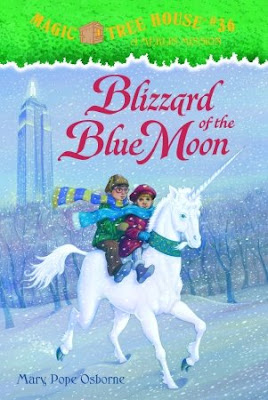
I read Blizzard of the Blue Moon with great delight. It’s number 36 in the popular “Magic Tree House” series. I must admit, it had been years since I read any books from this collection. My youngest daughter was an avid fan and she introduced me these stories, which, I, too, fell in love with. My personal favorite: Sunset of the Sabertooth. My daughter's favorite is Mummies in the Morning.
Blizzard of the Blue Moon’s setting is New York during 1938. As with all the books in this series, the main characters, siblings Jack and Annie, are on a mission – in this case, to save a unicorn. The great thing about this book, in relation to the depression era, is Sal Murdocca’s illustrations and the unique way author, Mary Pope Osborne, weaves history into her suspenseful plot.
Murdocca comments at the end of the book how much he enjoyed illustrating this book - and it shows. His illustrations capture the essence of the era with period automobiles, cityscapes and Central Park. I especially enjoyed the beautiful drawing of Belvedere Castle that factors into the story. I was unfamiliar with the building and enjoyed learning about its history. My family and I plan a visit to New York this summer. The last time I went, I wanted to see the Bethesda Fountain. This time, I’ll make a point of seeing the castle.
Ms. Osborne mixes an interesting combination of fact and fiction. As the children find themselves wondering around New York City on their quest to find the unicorn, they follow a path that takes them to various NYC landmarks. They start their journey in Central Park where they stumble upon the castle mentioned above. They witness soup lines and people wrapped in newspaper trying to stay warm while on route to the Bronx Zoo. There is a subway ride and a taxi ride before they end up at the ‘Cloisters of the Metropolitan Museum’ where she offers a subtle history lesson on the collection of art and artifacts housed there. Another place I hope to visit when I travel to NYC.
Osborne, Mary Pope, Blizzard of the Blue Moon. Illus. Sal Murdocca. New York : Random House, 2006. (0-375-83037-5)
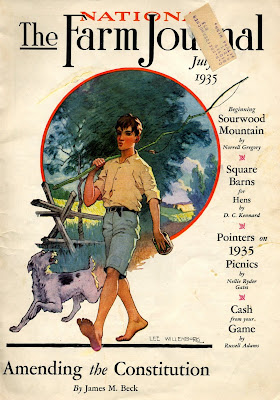
The photograph at left shows the cover of The Farm Journal, July, 1935. It was published by the Wilmer Atkinson Company in Philadelphia, Pennsylvania.
Inside, there are recipes, an article on how to grow late summer flowers, a piece on barn architecture and it's relationship to hen rearing and stories for leisure reading. What caught my eye was the story on page 16.
Children and Books : Have a home library plan and adhere to it, by Jean Kirk.
Ms. Kirk wrote, "But when there are no libraries near at hand and not so many dollars to spend on books, what are parents going to do to keep up with the growing demands for knowledge that are being made by their children?"
She goes on to share the story of a mother who compiled poetry, craft articles, educational pieces and picture books. This mother bound her 'library' of information with 'heavy wire fasteners'. In one volume, or perhaps many, the article doesn't quite say, this mother created her own library, specific to her interests, needs and objectives.
We do the very same thing, today. It's called 'Cut','Paste' and 'File'. No scissors required!
Becky
I recently contacted author, Gretchen Moran Laskas and asked her to share some background on how she came to write this book. For more information, be sure to check out her awesome website. Thanks, Gretchen!!
"This book comes out of a life lived from West Virginia, where I was born, to where I now live, just outside of Washington, DC. Sometimes the gulf between those worlds seems incredible, and nowhere was this more clear to me than in the story of Arthurdale. Reading the official reports about Arthurdale and the Homestead Act of the New Deal, one word comes up over and over again -- failure, failure, failure. But I knew that it hadn't been a failure. Flawed, yes, failure no. My father was born in Arthurdale, and I still have family who live in the town today. This was a town that took people from demoralizing poverty and elevated them within a single generation into the middle class. It was a grand experiment that contributes to the way we design towns today. This town is a symbol of government coming into people's lives and given them the hand up and hope they needed to create their own robust lives.
I am passionate about bringing to life the world of West Virginia for people who don't know (or think they know, though stereotypes) the state where my family has lived for eight generations. I've been writing about the state for more than fifteen years, and my own career, like the mountains that created it, has had its ups and downs. Writers and future writers should take note -- I've been rejected by someone for something more than 500 times and counting! But there is nothing like holding your own book in your hands and hearing from family and friends, to professional collegues and people around the world I've never met, that it is a job well done." Gretchen
http://lyonsmorris.com/glm/index.htm

Reading The Miner’s Daughter is like sitting on old, broken down porch steps, chatting with main character, Willa and her mentor, Miss Grace. The desolation of Riley Mines, a coal camp in West Virginia where the pair meets, is so authentic that the reader is literally taken to that place. At any moment, one expects little sister, Seraphina, to crash through the door or older brother, Ves to amble up the road, Daddy trailing behind, coughing from coal dust pneumonia.
Sixteen-year-old Willa’s life is a bleak one. As predicted, FDR’s election spells the shutdown of the coal mine where her father and brother worked. Her mother, weakened in both body and spirit by a recent childbirth, is unable to cope with the daily rigors of running a family under such austere circumstances.
The burden falls onto Willa, and while she rises to the challenge, she finds frustration by the monotony and seeming futility of trying to make right in a company town that is square set against her and her family.
Her world changes when Miss Grace comes to town. Miss Grace introduces Willa to books; not just the love of reading, but also the language of the written word. Through Miss Grace, Willa comes to understand that stories have powers that reach beyond entertainment or merely passing the time away.
Author Gretchen Moran Laskas does an amazing job of weaving excerpts from literary classics into Willa’s narrative to convey the connection in a Depression era setting. At one point, when Willa is determined to find fieldwork, her only option for income, Willa likens herself to Jo March, from Little Women, cutting her hair and taking on a boy’s persona – the only way to land work when employment was so scarce only men earned the right to hold a paying job.
Her use of Poe’s Eldorado, a poem Miss Grace describes as meaning, ‘perfect place’ takes the story full circle when Willa and her family actually move to Arthurdale. When Willa first reads the poem, about a man looking for utopia, she’s still in Riley Mines. Her idea of utopia is nothing more than freeing herself from the monotony of daily chores and financial worries. But once her family moves to Arthurdale, a utopian-type homestead community of Eleanor Roosevelt’s nurturing and one her family is chosen to join, she finds that the idea of utopia has many shades of meaning.
Laskas, Gretchen Moran. The Miner's Daughter. New York : Simon & Schuster Children's Publishing, 2007. 9781416912620 (hc) 1416912622 (hc).http://www.simonsays.com/content/book.cfm?tab=1&pid=524619&er=9781416912620
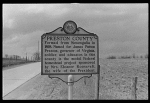 The title of the photograph at left is:
The title of the photograph at left is:Entering Preston County, West Virginia. Sign refers to Arthurdale Project.
Library of Congress, Prints & Photographs Division, FSA-OWI Collection,
LC-USF33-T01-001374-M3 DLC (b&w film dup. neg.)
It's tough to read, but I thought it was a great image to introduce the topic this week. After FDR came into office, many programs were put in place to help ease the suffering of Americans. One project was the creation of a homestead community called Arthurdale. Eleanor Roosevelt played an active role in the town's creation.
The former First Lady plays a role in The Miner's Daughter, the next book I'll review. It was written by Gretchen Moran Laskas and tells the story of, Willa and how she came to live at Arthurdale.
It's the first Young Adult book I've reviewed and I wanted to choose one that had a particular theme. Willa's journey from her coal mining town to Arthurdale is inspiring as well as historic!
Here's a link to the award winning site of Arthurdale Heritage, Inc. It's a great site, full of information, photographs, etc. that details the history of Arthurdale. http://www.arthurdaleheritage.org/
I think this is going to be a great topic!
Becky
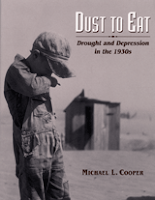
Michael L. Cooper, author of the Kite Award winning, Dust to Eat : Drought and Depression in the 1930’s, opens his book with a study of the migration of dust bowl refugees to California. Labeled “Okies”, Cooper explores their experiences within the context of John Steinbeck’s writings. He discusses how Steinbeck, shocked by the squalor and poverty of the homeless, felt moved to write “The Grapes of Wrath” in a matter of weeks. The many quotes and background details offer a good introduction to Steinbeck.
Cooper turns his attention to the catalyst for the massive migration: the dust bowl. He spends a chapter outlining the storms: their magnitude, paths and duration. He also studies how repeated plowing and drought conditions left the soil vulnerable to strong winds. Harsh weather conditions, overuse of the land and the declining economy were all factors that forced people from their homes, states and lives.
I have noted before, that I am a big fan of Caroline A. Henderson. I love her ability to walk a reader back into her time and place. Cooper opens his book with an introduction that features a quote by Henderson. He then does a wonderful job of culling specific Henderson text to compliment his overall message of dust bowl life. A particularly poignant story highlights just how harsh country life had become. Henderson talks about how a bedraggled jackrabbit, once a master of the open prairie, had sought refuge in her woodpile.
Cooper goes on to outline the laws and programs Roosevelt instituted in his first few months of office to help turn the economy around and put people back to work. He uses a combination of songs, oral histories and news accounts to describe how migrants traveled any way they could to get to the promise that was California. But once there, they faced discrimination, prejudice and continued unemployment. It took the onset of WWII to turn the economy around.
Black and white photographs, newspaper headlines and posters fill nearly every page making the book visually appealing. Woody Guthrie song lyrics add an authentic flavor to the period the book discusses. There is also a comprehensive appendix that lists books, websites, movies and museum information for student who want to learn more about the dust bowl and the 1930’s.
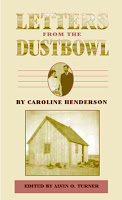
In a March 13, 1936 letter to her friend, Eva, Caroline A. Henderson wrote:
"It has been a terrible week, with one day of almost complete obscurity, and others when only a part of the sun's rays struggled throught the gloom with a strange bluish luminance. On such days each little wave of the troubled water in the stock tank glitters with a blue phosphorescent light. When I dip out a pail of water to carry to the henhouse, it looks almost as if it were covered with a film of oil. On days like this, when William Vaughn Moody's expression 'dust to eat' suggests a literal danger, we can't help questioning whether the traits we would rather think of as courage and perseverance are not actually recklessness and inertia. Who shall say?"
In this excerpt from a letter, one of several published by The Atlantic Monthly in an article entitled, “Letters from the Dust Bowl”, May 1936, pp. 540-551, Henderson does not merely offer a glimpse into life during the dust bowl years; her detailed depictions bring the era to life. A reader can almost touch the viscosity of the water as it sloshes in the pail. Her reference to Moody is a device she uses often when she cites other authors and their works and uses their words to enrich her own. She completes her portraits of life in the Oklahoma dust bowl with her humanly honest accounts of storms, financial calamities and ebbing emotional reserves.
I start my discussion on the dust bowl with an entry by Caroline A. Henderson for two reasons. First, I’ve always admired her mastery of language and her ability to describe her surroundings in such a way that it allows a reader entry into her world. Second, award winning author, Michael L. Cooper uses many excerpts from Henderson’s writings in his book, Dust to Eat : Drought and Depression in the 1930’s. I will review Cooper’s book as part of this exploration of depression era dust storms and the resulting disastrous effects during the Great Depression.
By:
Dust Bowl History,
on 3/4/2008
Blog:
Dust Bowl History
(
Login to Add to MyJacketFlap)
JacketFlap tags:
Ramblin' Rudy,
britt,
hobo convention,
Hobo Museum,
Dandi Daley Mackall,
hobo marking system,
Iowa,
hobo marking system,
Ramblin' Rudy,
britt,
hobo convention,
Hobo Museum,
Dandi Daley Mackall,
Add a tag

The illustration at right is my version of a hobo mark found in Dandi Daley Mackall's glossary in her book, Rudy Rides the Rails : A Depression Era Story. I've seen other versions of cats as marks and the common thread seems to be 'kindness" or "kindhearted".
I thought I'd include a mark with this entry because Ms. Mackall talks about this very topic as she shares how she came to meet Rudy and what inspired her interest in hobos. Enjoy!
Dandi Daley Mackall wrote:
"When I was a kid, I remember my grandmother telling me about the hoboes who hopped off the freights in our little town of Hamilton, Missouri. She said they’d walk up the tracks, past four houses, and head straight for her house. She’d always give them something—usually a piece of pie; but she wondered how they knew. Then a friend showed her that the big tree in front of her house had a carving on it, the face of a smiling cat.
Years later (and a couple of hundred books later), I thought about the symbol and started researching other hobo signs. Then I got hooked. I read and read about the Depression and the hoboes. I hopped onto Internet bulletin boards and joined discussions. I “met” groups of modern hoboes, lots of college and seminary professors, who spend summers hopping freights across the country. Several of them told me, “You have to talk to Rudy Phillips, perhaps the oldest living hobo who rode the rails in the Great Depression.”
So one Sunday, I called Rudy in Shawneetown, IL. We talked for over an hour that day, and Rudy delighted me with stories of hobo jungles and “catching the blue,” “riding the cowcatcher.” After that, I phoned him every Sunday, and we talked—he talked, and I listened. I sent him a tape recorder and tapes and a mailer, and he talked for hours, recalling the smell of the boxcar, the routes and changing stations, what people were wearing—all the great details. Finally, my husband and I journeyed to see Rudy. I spent a whole day with him, and he was even better in person. Rudy was 90 when I was working on this book (and my husband said as we drove home—“90 years old, and the guy was hitting on you!” Rudy gave me the dictionary of hobo signs that appears in the back of the book, along with definitions and terms, which I’ve defined in the glossary. He knew all about the book I was writing, although he died just before it came out. I dedicated the book to Rudy, who “caught the Westbound,” the term he used for his old friends passing on to a better life.
After the book came out this past year, I was invited to join in the International Hobo Convention in Britt, IA. It was wonderful to meet so many who knew and loved Rudy—what great people, and what a terrific heritage. Many of the hoboes—like Mama Jo and Hobo Santa--now have ministries to the homeless.
Dear Dandi,
Thank you so sharing this beautiful story! I've included a link to the Hobo Museum in Britt, Iowa. Dandi will be among the celebrated guests at the next convention in July, 2008. Good luck, Dandi, and thank you, again!!
Becky
 Rudy was just a teenager when he hopped his first train. He hoped to find work so he could send some money home. He also hoped to be one less mouth for his folks to feed.
Rudy was just a teenager when he hopped his first train. He hoped to find work so he could send some money home. He also hoped to be one less mouth for his folks to feed.
Rudy Rides the Rails : A Depression Era Story tells a fictionalized account of real life hobo, Ramblin' Rudy's journey to California and back. The story follows the lad as he leaves his Ohio home and journeys across the country, meeting hobos, finding work where ever he can, and learning the hard lessons on how to survive riding the trains.
Author Dandi Daley Mackall does a good job detailing the perils Rudy faced, such as catching cinders from the trains' stack, out running rail yard 'bulls' and finding work.
What is particularly fascinating is the book's treatment of the hobo marking system. Hobo culture used a relatively simple set of 'marks' or signs as a way to leave messages to future hobos who happen to travel the same path. The sign of a cat's face meant the home or business was kind, while a rectangle with a dot in the center meant the place was hostile or dangerous. They used arrows to show directions, circles with X's to show where one could get a handout and an empty zero to indicate the house offered nothing. Mackall includes a grouping of the marks in her glossary.
Another unique aspect of her book is her use of jargon common among hobos. The 'Sally' was the Salvation Army, 'Cali' was California and 'Casey' was Kansas City, Missouri, just to name a few. The jargon is peppered throughout the book and gives the story an authentic flavor for the era it describes.
Chris Ellison's illustrations also lend authenticity to that by-gone era when at one moment a boy could be running in a field and riding in an empty rail car the next. His thick brush strokes accentuate the billowing steam from the engines and the starkness of wooden trains.
Despite the fact that Rudy Rides the Rails is laid out as a Picture Book, its rich detail and engaging illustrations will make it an interesting story for readers of all ages.
Watch for a wonderful account of the history of this story when I share a letter from Dandi Daley Mackall in my next post!
Becky
Dandi Daley Mackall website :http://www.dandibooks.com/
Chris Ellison website : http://www.sleepingbearpress.com/authors_illustrators/chris_ellison.htm
Book information : http://gale.cengage.com/servlet/ItemDetailServlet?region=9&imprint=k12&titleCode=SB56&type=4&id=226349
By:
Dust Bowl History,
on 2/27/2008
Blog:
Dust Bowl History
(
Login to Add to MyJacketFlap)
JacketFlap tags:
hobo marking system,
Hobo,
Box Car Bertha,
Tramp,
railroad,
Riding the Rails,
Box Car Bertha,
Tramp,
railroad,
Hobo,
hobo marking system,
Riding the Rails,
Add a tag
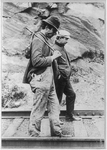 "I never told you about, some of the tramps we used to have, did I? The ones that came to be well known around here were all odd characters. I suppose you might say some of them weren't right, though that's matter of opinion. Maybe they was smarter than folks who looked down on them. Maybe they got more satisfaction out of life in their own way than some who were better off."
"I never told you about, some of the tramps we used to have, did I? The ones that came to be well known around here were all odd characters. I suppose you might say some of them weren't right, though that's matter of opinion. Maybe they was smarter than folks who looked down on them. Maybe they got more satisfaction out of life in their own way than some who were better off."
Connecticut Clockmaker as interviewed by writer Francis Donovan 12/31/38 (?)Library of Congress, Manuscript Division, WPA Federal Writers' Project Collection.
Photograph: Two hobos walking along railroad tracks, after being put off a train. Library of Congress Prints and Photographs Division
Riding the Rails and all that that entails!
I'd purchased Rudy Rides the Rails by Dandi Daley Mackall (Illus. Chris Ellison) a few weeks ago. It is another picture book set during the Great Depression that was published after my book came out and which I plan to review.
Simply by its title, the reader knows what the book will be about. So it comes as sheer coincidence that I spent the better part of last week and the weekend reading about rail riding and hobo life during the 1930's. I was conducting research for another project, reading such works as Sister of the Road (an autobiography of Box-Car Bertha), The Tramp in America, Boy and Girl Tramps of America,(author Thomas Minehan actually road with the train-hopping hobos and offers amazing insight), and works by noted writer and sociologist, Nels Anderson (see bibliography below).
Mackall's book touches on many of the themes i.e. the various ways a person could ride a train, hobo jungles, begging.
What is fun about her book, for me, at least, is that the hobo she features in her story actually rides a train through Waterloo, Iowa, a city just east of where I live. She also has her main character travel through Britt, Iowa, which bills itself as home to the National Hobo Convention. The city of Britt even houses a museum. http://www.brittiowa.com/
I'll expand on this topic in the next couple of entries!
Becky
Anderson, Nels On Hobos and Homelessness. Chicago : University of Chicago Press, 1998.
Bruns, Roger A. Knights of the Road : A Hobo History. New York : Methuen, 1980.
Cresswell, Tim The Tramp in America. London : Reaktion Books, 2001.
Minehan, Thomas Boy and Girl Tramps of America. New York : Farrar and Rinehart, 1934.
Reitman, Dr. Ben L. Sister of the Road : The Autobiography of Box-Car Bertha. New York : Harper Colophon Books, 1975.
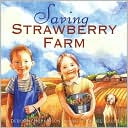
As promised, one of the goals of this blog is to dig a little deeper into the issues and topics that concern the Great Depression. One way to do that will be to offer 'visits' with authors I've reviewed.
We are very fortunate to have our first visit be with Deborah Hopkinson, author of Saving Strawberry Farm, reviewed on February 7th. I asked her if she would share how she came to write the book, what served as her inspiration. Here is her reply!
Ms. Hopkinson wrote:
Stories come about in odd ways sometimes. SAVING STRAWBERRY FARM was written several years ago, while I was living in Walla Walla, Washington. Our house was just a half mile from a wonderful place called Klickers. Klickers is a local institution: one one side, the store sells antiques and reproductions, candles,soap and old-fashioned candy. Another section includes local produce and Walla Walla sweet onions in the summer, and Christmas ornaments and wreaths during the holiday season. The field next to the store becomes a pumpkin patch in October, and a Christmas tree stand in December. There are even reindeer in the barn!
But Klickers is most famous most for its strawberries. In the years we lived in the area, I sometimes picked with my husband and two children, but more often visited the U Pick fields alone on a Sunday morning. And so I was inspired by that experience of early summer and the wonderful sweetness of fresh strawberries.
That's one part of the inspiration for SAVING STRAWBERRY FARM. The other came from a small book entitled A Nickel's Worth of Skim Milk: A Boy's View of the Great Depression, by Robert Hastings. First published in 1972, the memoir captured a family's experiences in Southern Illinois in the 1930s. I also researched penny auctions, and somehow all these elements came together in this story.
Most of my historical fiction and nonfiction books take place in the 19th century. I did, however, have the chance to research and read more about the Great Depression while writing my nonfiction book, UP BEFORE DAYBREAK: COTTON AND PEOPLE IN AMERICA. We are fortunate that many oral histories of factory workers and former slaves were collected during the Depression through the Federal Writers Project, and are now available online through American Memory from the Library of Congress.
I think my favorite part of writing is that it gives me the opportunity to continue to learn. That is true both for my work as a writer and my "day job," raising money to support the work of ChristieCare, an organization that provides mental health services to children here in Oregon, I hope that reading my books will spur others to be curious and want to learn more about ordinary people in history. This fall my new picture book, ABE LINCOLN CROSSES A CREEK, will be released in honor of the 2009 bicentennial of Lincoln's birth. But this book also celebrates the life of another boy: Benjamin Austin Gollaher. To learn why he is important you'll just have to wait to read the book to find out!
Deborah Hopkinson
Thank you, Deborah!! What a great letter! I should mention that I've read Up Before Daybreak : Cotton and People in America - and loved it! Good luck with your next book! Thanks, again! - Becky
By:
Dust Bowl History,
on 2/14/2008
Blog:
Dust Bowl History
(
Login to Add to MyJacketFlap)
JacketFlap tags:
recipes,
cookbooks,
cookbooks,
gossamer pickles,
rag cake,
foamy omelet,
gossamer pickles,
rag cake,
foamy omelet,
Add a tag
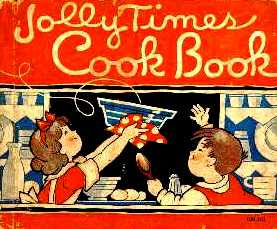 The depression era used some colorful names for food. Hobos called sausage "gut". A "foamy omelet" was baked, rather than fried, and resembled a souffle because the egg whites were beaten stiff before cooking. And a "Rag Cake", despite its unappetizing name, was a cake make with oil instead of the more expensive butter. In fact, a "Rag Cake" is the same as the more elegantly named, "Chiffon Cake." Chiffon, in french, means cleaning cloth...or rag!
The depression era used some colorful names for food. Hobos called sausage "gut". A "foamy omelet" was baked, rather than fried, and resembled a souffle because the egg whites were beaten stiff before cooking. And a "Rag Cake", despite its unappetizing name, was a cake make with oil instead of the more expensive butter. In fact, a "Rag Cake" is the same as the more elegantly named, "Chiffon Cake." Chiffon, in french, means cleaning cloth...or rag!
I chose the following recipe from Jolly Times Cook Book : Simple Recipes for Young Beginners. Like many recipes from that time, this recipe has a unique, and inviting name. The book suggests the fluff be served with "tomatoes, Gossamer Pickles, Tumbling Bisquits, and fruit sherbert." I can't quite tell if this casserole is incredibly delicious, or just the opposite. While I have not made it, it appears to be a dish along the lines of french bread with cheese. The mustard threw me. I suppose you could leave it out. Bon appetite...and pass the Gossamer Pickles!
Cheese Fluff
4 slices white bread of medium thickness (this recipe assumes the bread was homemade)
1 pound American cheese (approx. 6-8 slices of American Cheese will be adequate)
1 tsp. salt
1/2 tsp. dry mustard
2 eggs
1 C. milk
The recipe calls for a large casserole pan be greased with butter. (While it does not indicate the exact size of the pan, I'd suggest a 9x13 pan.) Break the bread into pieces and layer evenly on the bottom of the pan. Place cheese slices evenly over bread. Combine the salt and mustard, then sprinkle over bread and cheese. Beat eggs and milk together. Pour mixture over bread and cheese. Cover for one hour so bread can absorb egg/milk mixture.
Uncover and bake in a 350 degree oven for 45 minutes. While I've modified the directions to suit how we cook, today, it is interesting to note that the original recipe instructs to "uncover casserole and place in a cold oven. Light fire, and bake.." In the 1930's, cooking stoves would have had to been 'lit', as opposed to merely turning a knob.
Osborn, Marjorie Noble Jolly Times Cook Book. Illus. Clarence Biers. Chicago : Rand McNally & Company, 1934.
Ok, I couldn't resist: Gossamer Pickles! Layer dill pickle slices with granulated sugar. After several layers, top with a final layer of sugar. Place in refridgerator for four or five days before serving.
Becky
 When I originally wrote my book, The Great Depression in Literature for Youth, Deborah Hopkinson's book was on my radar. The only trouble was I couldn't get my hands on an actual copy. I knew, from what little I could find about this book, that it was set during the depression and that the story involved an auction. So even though I hadn't actually read the book, I felt its theme matched the purpose of my book, so I included it with a simple, one line description. Now that I have read, Saving Strawberry Farm, I'd like to expand on my original description.
When I originally wrote my book, The Great Depression in Literature for Youth, Deborah Hopkinson's book was on my radar. The only trouble was I couldn't get my hands on an actual copy. I knew, from what little I could find about this book, that it was set during the depression and that the story involved an auction. So even though I hadn't actually read the book, I felt its theme matched the purpose of my book, so I included it with a simple, one line description. Now that I have read, Saving Strawberry Farm, I'd like to expand on my original description.
The first thing I noticed about this charming book were the vibrant illustrations. Rachel Isadora used colored pencils to create engaging scenes that depict the era, right down to main character, Davey's blue overalls. Set on a hot summer day, Davey is sent to buy ice. While at the general store, he learns that the local strawberry farm will be auctioned off because the owner, Miss Elsie, cannot pay her mortgage. Can Davey find a way to help Miss Elsie before she loses her land forever?
Ms. Hopkinson offers a detail account of how neighbors rallied to the aid of people about to lose their land by holding a penny auction. She describes how the people banded together to keep the sale price of the farm so low, Miss Elsie was able to buy it back from the bank, thereby saving her strawberry farm.
An Author's Note is included that gives background information on the depression, farm auctions and small grocery stores from that era, like the one featured in the story.
Leah's Pony by Elizabeth Friedrich (Illus. by Michael Garland) is another book that features a penny auction. But in this book, instead of one parcel of land being sold, it details how household items, including a prized pony, could be auctioned, too.
Happy reading!
Becky
Hello!
I'm glad you found your way to my blog! We're here to talk history - The Great Depression, to be more specific. As this is my first post, I should warn you...I have no formula or plan. Each entry will be as different as the experiences of people across the country during the 1930's. One day I might talk about dust. Another day I might review a book. Still, another day, I might share a recipe or household tip people used to get by during that period.
I've always been fascinated by the The Great Depression. I think we are all familiar with its major themes which include the stock market crash, the dust bowl, migrant workers and economic crisis. I might write about those topics, from time to time, but what fascinates me more, is the idea of how differently the depression affected people, depending on where they lived.
It was also a very resourceful period. People made do because they had to - and quite creatively, at that.
I think it will be fun to explore the different geographical experiences and 'can do' spirits of Americans during the Depression era.
Hope you enjoy it, too.
Becky
 From the Library of Congress 'Prints and Photographs Online' collection.
From the Library of Congress 'Prints and Photographs Online' collection.  A recipe for Apricot Nut Bread was published in the October 18, 1930 Homemaking Department section of the Wallaces' Farmer newspaper. Curious, not once was the type or quantity of nut mentioned in the entire recipe. As the newspaper was regional to the midwest, perhaps it was a given walnuts were the obvious choice - or chestnuts.
A recipe for Apricot Nut Bread was published in the October 18, 1930 Homemaking Department section of the Wallaces' Farmer newspaper. Curious, not once was the type or quantity of nut mentioned in the entire recipe. As the newspaper was regional to the midwest, perhaps it was a given walnuts were the obvious choice - or chestnuts. St. Nicholas Magazine advertisement illustration, October 1933.
St. Nicholas Magazine advertisement illustration, October 1933.  During the thirties, boys and girls loved to read St. Nicholas.
During the thirties, boys and girls loved to read St. Nicholas. 
 Rudy was just a teenager when he hopped his first train. He hoped to find work so he could send some money home. He also hoped to be one less mouth for his folks to feed.
Rudy was just a teenager when he hopped his first train. He hoped to find work so he could send some money home. He also hoped to be one less mouth for his folks to feed.  "I never told you about, some of the tramps we used to have, did I? The ones that came to be well known around here were all odd characters. I suppose you might say some of them weren't right, though that's matter of opinion. Maybe they was smarter than folks who looked down on them. Maybe they got more satisfaction out of life in their own way than some who were better off."
"I never told you about, some of the tramps we used to have, did I? The ones that came to be well known around here were all odd characters. I suppose you might say some of them weren't right, though that's matter of opinion. Maybe they was smarter than folks who looked down on them. Maybe they got more satisfaction out of life in their own way than some who were better off."  The depression era used some colorful names for food. Hobos called sausage "gut". A "foamy omelet" was baked, rather than fried, and resembled a souffle because the egg whites were beaten stiff before cooking. And a "Rag Cake", despite its unappetizing name, was a cake make with oil instead of the more expensive butter. In fact, a "Rag Cake" is the same as the more elegantly named, "Chiffon Cake." Chiffon, in french, means cleaning cloth...or rag!
The depression era used some colorful names for food. Hobos called sausage "gut". A "foamy omelet" was baked, rather than fried, and resembled a souffle because the egg whites were beaten stiff before cooking. And a "Rag Cake", despite its unappetizing name, was a cake make with oil instead of the more expensive butter. In fact, a "Rag Cake" is the same as the more elegantly named, "Chiffon Cake." Chiffon, in french, means cleaning cloth...or rag! When I originally wrote my book, The Great Depression in Literature for Youth, Deborah Hopkinson's book was on my radar. The only trouble was I couldn't get my hands on an actual copy. I knew, from what little I could find about this book, that it was set during the depression and that the story involved an auction. So even though I hadn't actually read the book, I felt its theme matched the purpose of my book, so I included it with a simple, one line description. Now that I have read, Saving Strawberry Farm, I'd like to expand on my original description.
When I originally wrote my book, The Great Depression in Literature for Youth, Deborah Hopkinson's book was on my radar. The only trouble was I couldn't get my hands on an actual copy. I knew, from what little I could find about this book, that it was set during the depression and that the story involved an auction. So even though I hadn't actually read the book, I felt its theme matched the purpose of my book, so I included it with a simple, one line description. Now that I have read, Saving Strawberry Farm, I'd like to expand on my original description. 











